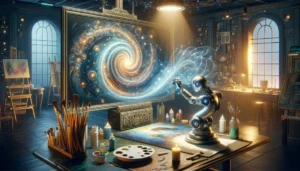At the intersection of technology and creativity, Artificial Intelligence (AI) is redefining what we consider possible in the world of art. Far from being mere automation tools, AI systems like Generative Adversarial Networks (GANs) are emerging as unexpected collaborators in the creative process.
Challenging our traditional conceptions of art and authorship, this post explores the fascinating world of AI in art. We open up the discussion about its revolutionary impact, the complex ethical questions it raises, and we contemplate the broad implications for the future of creative expression in an era dominated by technology.
The Emergence of AI-Assisted Art
Historically, the introduction of new technologies has always catalyzed artistic innovations, from photography to digital art. Now, AI redefines art, acting not only as a tool, but as a creator. Algorithms like GANs allow it to produce everything from images to literary texts, challenging the boundaries between man-made and machine-generated.
How the Art of AI Works
To understand how AI is creating art, it is crucial to understand the basics of GANs. These networks involve two AI models working together: a generator, which creates images, and a discriminator, which evaluates these images by comparing them with a dataset of real works of art. Through this iterative process of trial and error, the generator learns to produce increasingly convincing works, often indistinguishable from those created by humans.

Impressive Examples and Repercussions
The world has already witnessed stunning examples of AI's creative capabilities. From portraits that look like they were painted by masters of the past to musical compositions in the styles of great composers, AI is constantly surprising us with its versatility. One notable example was the sale of an AI-created portrait for a significant sum at a traditional art auction, a milestone that signals the growing acceptance of AI art in the mainstream art world.
Ethical and Authorship Issues
AI-created art raises important questions about authorship and originality. When a work of art is generated by an algorithm, who is the real artist? Is it the creator of the algorithm, the algorithm itself, or the machine that runs the software? Furthermore, AI's ability to replicate styles could lead to debates about copyright and the essence of human creativity. These are complex issues that require continuous dialogue between artists, technologists, jurists and philosophers.
The Future of Art with AI
Looking to the future, the integration of AI into art promises not only new forms of creation, but also an expansion of access to art. AI can democratize art creation, allowing people without traditional artistic training to express their creative visions in previously unimaginable ways. Furthermore, AI can serve as a collaboration tool, where humans and machines work together to explore new creative territories.
Conclusion
A New Era of Creative Exploration
The incorporation of AI into art is taking us into a new era of creative exploration, where the barriers between the human and the technological become increasingly blurred. Far from threatening traditional art, AI offers a wide range of new possibilities and perspectives, opening up unexplored avenues for creative expression. Like any tool, the key is how we use it, which challenges us to rethink our approaches and creative methods.
AI art invites us to rethink not only what we consider art, but also what it means to be a creator in the digital age. As we move forward on this journey, it is essential to maintain an open and thoughtful dialogue about the role of technology in creative expression. We must ensure that we continue to value the uniqueness of the human perspective, which remains at the heart of art, even amid unprecedented technological advances.
